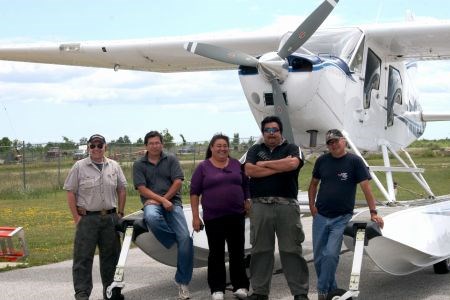A Sault Ste. Marie company is teaming up with the Wikwemikong Unceded Indian Reserve on a unique venture that will bring the pairing to the forefront of forest measuring, reporting and verification (MRV) in the province.
Wikwemikong has secured $2.4 million worth of contracts with the Ontario government to map out the Pineland Forest, Algonquin Provincial Park and French-Severn Forest units for the Ontario government. It will mean revenue and jobs for the Manitoulin Island First Nation, and Terrafact, with its MRV expertise, is providing the training.
“It’s a first for a First Nation,” said Wikwemikong land use planner John Manitowabi. “A First Nation's never been awarded any kind of forest resource industry contract – it's always been one of the established companies out there in Canada – so getting three of them at $2.4 million is even better.”
Work is already underway on the first phase of the project, which involves field sampling by about 30 forest technicians hired by Wikwemikong. Following sector lines identified by the Ministry of Natural Resources (MNR) within the different forest units, they will record tree species, the ages and measurements, soil conditions, and basal areas, which help identify the maturity of the forest, on plots located about 60 metres apart.
“That gives them all the information they need to determine what the forest's like in those areas, so that when they do forest management planning, they have up-to-date information as to what the forest age is, the stands, what kinds of trees are found in an area and the health of it as well,” Manitowabi said.
In phase two, set to start this month, the technicians will use geographic information systems (GIS) and 3D technology to analyze aerial photographs of the forest units, while the third phase involves getting to more remote areas.
Wikwemikong is already planning to vie for the next round of contracts, expected to be tendered soon, Manitowabi said.
“This could be a three- to four-year project,” he said. “So, if we're successful, we'll make some revenue and, at the same time, we'll build capacity for our First Nation here and hopefully be a leader in forestry in that type of work once we're done.”
While this area of expertise isn’t new for Rob Cormier, his company, Terrafact, is. It’s a spinoff of his sister company, R&B Cormier, which has a long history of consultation and contracting for the forest management industry.
“When we started Terrafact with our senior staff, the idea was to take some of the skills and technology that we developed at R&B Cormier and get involved more in partnerships and training,” Cormier explained. “That's what we've done with Wiky. (Wikwemikong)”
Terrafact will supply the expertise and training, and Wikwemikong will supply the manpower, building up its experience. The partnership will work out of Algoma University’s new Biosciences and Technology Convergence Centre, which Cormier calls “the absolute perfect venue” for the high-end remote-sensing work, because of the state-of-the-art facilities and the support offered by the university.
The initiative with Wikwemikong is the first collaboration for Terrafact, but the relationship between Cormier and the First Nation dates back to the mid-’90s when Cormier started doing forest management consulting for the band. The mutual respect between the partners is palpable.
“It’s a pleasure to actually be partnered with somebody with the integrity and business ethic that John brings to the table,” Cormier said. “It’s refreshing.”
Manitowabi said the First Nation would never have been able to get the project off the ground without Terrafact, and he’s confident in the viability of their partnership, which is looking at branching out to service clients in South America, Peru, Chile and the Congo.
Forest analysis is just the first stage of a long-term plan for Wikwemikong. A band-directed proposal is currently in the works to establish a forestry centre of excellence on the reserve, which would be a model for other First Nations across the province.
Manitowabi is currently researching the possibility of reviving the Aboriginal resource technician program at Sault College, and he noted the history of Wikwemikong’s fire crews as respected forest firefighters across the province.
“It's a lot of work, but it's going to be rewarding in the end,” he said of the centre. “It gets Wiky on the map, just to show that it's not another First Nation that sits by the wayside, that we're trying to demonstrate that we can work just as any person out there. We're able to work with the technology out there and utilize it to our advantage.”




